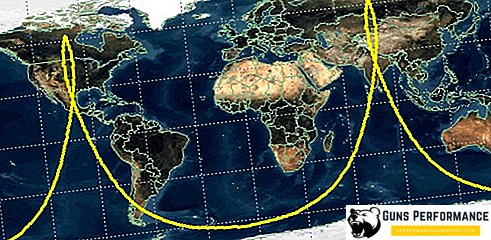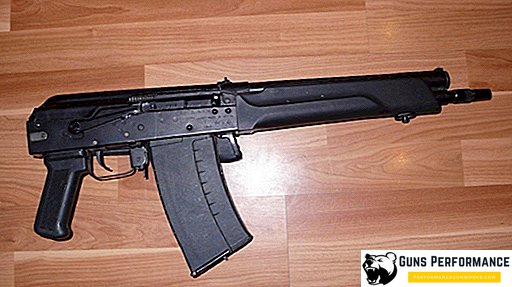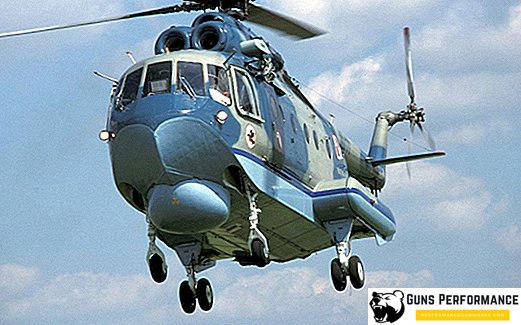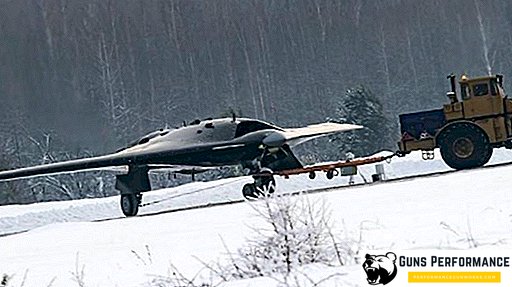September 11, 2007 in Russia successfully passed the tests of the most powerful non-nuclear munitions in the world. A strategic bomber Tu-160 dropped a bomb weighing 7.1 tons and a capacity of about 40 tons in TNT equivalent with a guaranteed radius of destruction of all living more than three hundred meters. In Russia, this ammunition received the nickname "Dad of all bombs." He belonged to the class of ammunition volumetric explosion.
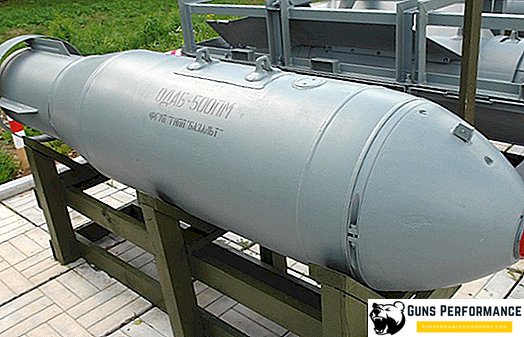
The development and testing of a munition called "Daddy of All Bombs" is the US response to Russia. Up to this point, the most powerful non-nuclear ammunition was considered the American bomb GBU-43B MOAB, which the developers themselves called the "Mother of All Bombs." The Russian "father" surpassed the "mom" in all respects. True, the American ammunition does not belong to the class of vacuum ammunition - it is the most common bomb.
Today, a volume explosion weapon is the second most powerful after a nuclear one. What is its principle of action based on? What explosive makes vacuum bombs equal in strength to thermonuclear monsters?
The principle of operation of ammunition volumetric explosion
Vacuum bombs or a volume explosion ammunition (or volume-detonating ammunition) is a type of ammunition that works on the principle of creating a volume explosion known to mankind for hundreds of years.
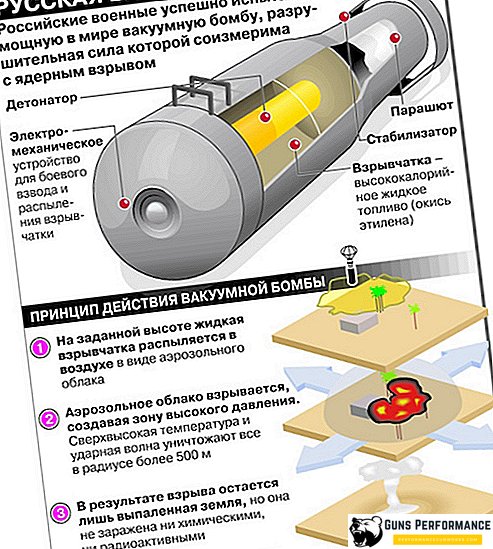
In terms of their power, such ammunition is comparable to nuclear charges. But unlike the latter, they do not have a factor of radiation contamination of the area and do not fall under any of the international conventions on weapons of mass destruction.
A man has long been acquainted with the phenomenon of a volumetric explosion. Such explosions quite often happened in the mills, where the smallest flour dust accumulated in the air or in sugar factories. Even more dangerous are explosions in coal mines. Bulk explosions are one of the most terrible dangers that lie in wait for miners underground. In poorly ventilated faces, coal dust and methane gas accumulate. To initiate a powerful explosion in such conditions, even a small spark is sufficient.
A typical example of a volumetric explosion is the explosion of domestic gas in a room.
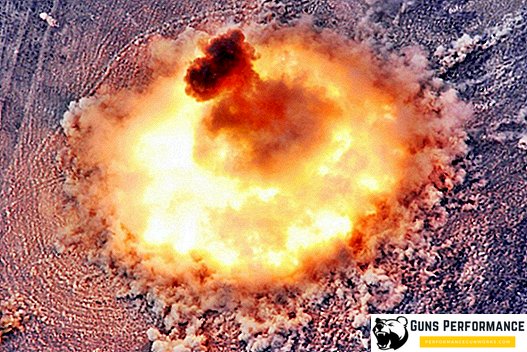
The physical principle of action by which the vacuum bomb operates is quite simple. Usually it uses an explosive with a low boiling point, which easily turns into a gaseous state even at low temperatures (for example, acetylene oxide). To create an artificial volumetric explosion, you just need to create a cloud from a mixture of air and combustible material and set it on fire. But it’s just only in theory - in practice this process is rather complicated.
In the center of the ammunition volumetric explosion is a small destructive charge, consisting of conventional explosives (explosives). Its function is to spray the main charge, which quickly turns into a gas or aerosol and reacts with oxygen in the air. It is the latter that plays the role of an oxidizing agent; therefore, a vacuum bomb is several times more powerful than a conventional one having the same mass.
The task of the blasting charge is to evenly distribute the combustible gas or aerosol in space. Then comes the second charge, which causes the detonation of this cloud. Sometimes use several charges. The delay between the triggers of two charges is less than one second (150 Moscow time).
The name "vacuum bomb" does not quite accurately reflect the principle of operation of this weapon. Yes, after the explosion of such a bomb, pressure does indeed drop, but we are not talking about any vacuum. In general, the ammunition of the volumetric explosion has already generated a large number of myths.

As an explosive in bulk ammunition, various liquids are usually used (ethylene oxide and propylene oxide, dimethylacetylene, propyl nitrite), as well as light metal powders (most often magnesium).
How does such a weapon work?
When a volume explosion is detonated, a shock wave arises, but it is much weaker than in the case of an ordinary TNT-type explosive. However, a shock wave operates during a volume explosion much longer than when conventional ammunition is blown up.
If we compare the effect of a normal charge with a pedestrian's blow by a truck, then the effect of a shock wave during a three-dimensional explosion is a skating rink, which not only passes slowly over the victim, but also stands on it.
However, the most mysterious striking factor of bulk ammunition is the low pressure wave that follows the shock front. On its action there are a large number of the most controversial opinions. There is evidence that it is the zone of reduced pressure that has the most destructive effect. However, this seems unlikely, since the pressure drop is only 0.15 atmosphere.
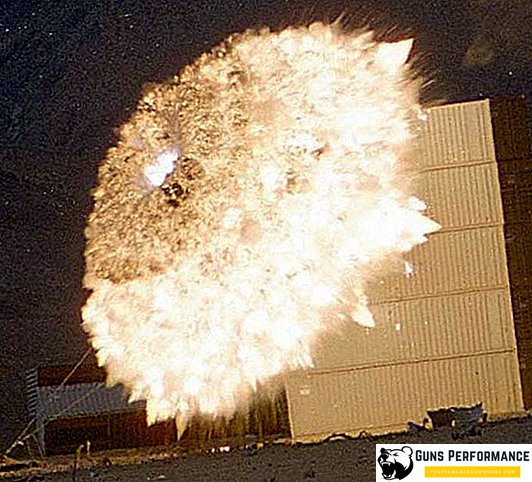
Jumpers in the water experience a short-term pressure drop of up to 0.5 atmosphere, and this does not lead to rupture of the lungs or loss of eyes from the sockets.
More effective and dangerous for the enemy ammunition volumetric explosion makes them another feature. The blast wave after the explosion of such a munition does not go around obstacles and does not reflect from them, but “flows” into every slot and cover. Therefore, to hide in a trench or dugout, if an aviation vacuum bomb is dropped on you, it will definitely not work.
The shock wave travels over the surface of the soil, so it is perfect for detonating anti-personnel and anti-tank mines.
Why all the ammunition did not become vacuum
The effectiveness of the volume explosion ammunition became apparent almost immediately after the start of their use. Undermining ten gallons (32 liters) of sprayed acetylene produced an effect equal to an explosion of 250 kg of TNT. Why all modern ammunition did not become bulky?
The reason lies in the characteristics of a volumetric explosion. Volume-detonating ammunition has just one damaging factor - the shock wave. Neither cumulative nor fragmentation action on the target they produce.
In addition, the ability to destroy the barrier they have is extremely small, since their explosion is of the type "burning". However, in most cases, an explosion of the "detonation" type is needed, which destroys obstacles in its path or throws them away.
The explosion of a bulk ammunition is possible only in the air; it cannot be produced in water or in the ground, since oxygen is needed to create a combustible cloud.
For successful use of space-detonating ammunition, weather conditions are important, which determine the success of the formation of a cloud of gas. It makes no sense to create volumetric ammunition of small caliber: aerial bombs weighing less than 100 kg and shells with a caliber of less than 220 mm.
In addition, for the bulk ammunition is very important trajectory of destruction of the target. They are most effective in the case of a vertical lesion of an object. On slow-motion shots of the explosion of a bulk ammunition, it is clear that the shock wave forms a toroidal cloud, best of all, when it "creeps" along the ground.
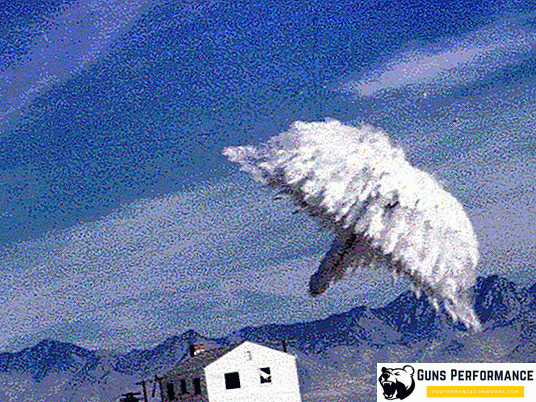
History of creation and application
The birth of their ammunition surround explosion (as well as many other weapons) are due to unkind German gun genius. During the last world war, the Germans drew attention to the power of explosions that occur in coal mines. They tried to use the same physical principles for the production of a new type of ammunition.
They didn’t get anything real, and after the defeat of Germany, these achievements fell to the allies. They have been forgotten for many decades. The first about the voluminous explosions were remembered by the Americans during the Vietnam War.
In Vietnam, the United States widely used combat helicopters, with which they supplied their troops and evacuated the wounded. A rather serious problem was the construction of landing sites in the jungle. Clearing the site for landing and takeoff of only one helicopter required the hard work of a whole engineer platoon for 12-24 hours. Clearing the site with conventional explosions was not possible, because they left behind huge craters. It was then that they remembered the ammunition of a voluminous explosion.
A combat helicopter could carry on board several such ammunition, the explosion of each of them created a platform quite suitable for landing.
The combat use of bulky ammunition was also very effective, they had a strong psychological effect on the Vietnamese. To hide from such an explosion was very problematic, even in a safe dugout or bunker. The Americans successfully used a volumetric explosion bomb to destroy partisans in tunnels. At the same time, the development of such ammunition began in the USSR.
The Americans equipped their first bombs with various types of hydrocarbons: ethylene, acetylene, propane, propylene, and others. In the USSR, experimented with a variety of metal powders.
However, the first-generation volumetric explosion munitions were quite demanding on the accuracy of bombing, depended heavily on weather conditions, and did not work well at negative temperatures.
For the development of second-generation ammunition, Americans used computers, on which they simulated a volumetric explosion. At the end of the 70s of the last century, the UN adopted a convention banning these weapons, but this did not stop its development in the United States and the USSR.
Today, third-generation volumetric explosion ammunition has been developed. Work in this direction is actively carried out in the United States, Germany, Israel, China, Japan and Russia.
"Dad of all bombs"
It should be noted that Russia is among the countries with the most advanced developments in the field of creating weapons of volumetric explosion. The high-power vacuum bomb tested in 2007 is a clear confirmation of this fact.
Until that time, the most powerful non-nuclear ammunition was considered to be the American aerial bomb GBU-43 / B, weighing 9.5 tons and 10 meters long. Americans themselves considered this controlled aerial bomb not too effective. In their opinion, it is better to use cluster munitions against tanks and infantry. It should also be noted that GBU-43 / B does not belong to bulk ammunition, it contains conventional explosives.
In 2007, after testing, Russia adopted a high-power vacuum bomb. This development is kept secret, neither the abbreviation that is assigned to the ammunition, nor the exact number of bombs that are in service with the Russian Armed Forces are known. It was stated that the power of this superbomb is 40-44 tons of TNT.
Due to the large weight of the bomb, the aircraft can only be the means of delivery for such ammunition. The leadership of the Russian Armed Forces stated that nanotechnology was used in the development of ammunition.



